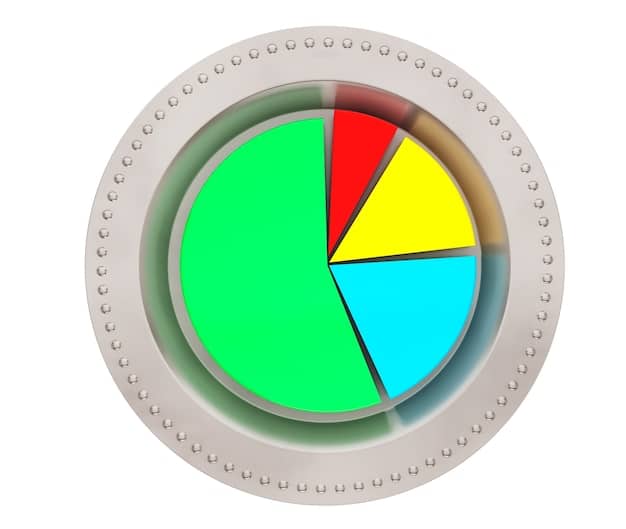Unlock Compound Interest: Grow $500 Monthly to $250K in 20 Years

Unlock the power of compound interest and learn how consistent investing of $500 monthly can potentially grow to $250,000 in 20 years by understanding investment options, calculating growth, and making informed financial decisions.
Discover how the magic of compound interest can turn modest monthly investments into substantial long-term wealth. Investing $500 a month might seem like a small step, but with disciplined saving and smart investment choices, you could potentially **unlock the power of compound interest**, reaching a portfolio of $250,000 in just 20 years.
Understanding Compound Interest and Its Potential
Compound interest is often called the “eighth wonder of the world” for a reason. It’s the process where the interest you earn on an investment also earns interest, leading to exponential growth over time. This is different from simple interest, where you only earn interest on the initial principal.
The beauty of compound interest lies in its ability to accelerate wealth accumulation silently and steadily. Let’s delve deeper into how it works and how you can harness it to achieve your financial goals.
The Formula for Compound Interest
The compound interest formula is a cornerstone for understanding how your investments grow. It’s expressed as:
A = P (1 + r/n)^(nt)
Where:
- A = the future value of the investment/loan, including interest
- P = the principal investment amount (the initial deposit or loan amount)
- r = the annual interest rate (as a decimal)
- n = the number of times that interest is compounded per year
- t = the number of years the money is invested or borrowed for
Understanding each component and how they interact allows you to predict the potential growth of your investments accurately.
Illustrating the Power with an Example
Imagine you invest $1,000 with an annual interest rate of 7%, compounded annually. After one year, you’d earn $70 in interest. But in the second year, you’d earn 7% on $1,070, not just the original $1,000. This difference becomes increasingly significant over time, demonstrating why compound interest is such a powerful tool for long-term investing.
In conclusion, understanding compound interest involves appreciating the time value of money and making informed decisions that allow your investments to grow exponentially. Recognizing its power can motivate you to start investing early and consistently.

The Strategy: Investing $500 Monthly
Consistent investing is a key strategy for building wealth, and setting aside $500 each month is an achievable goal for many. By building a habit of disciplined savings and investing, you can harness the power of compound interest more effectively.
Let’s explore strategies to maximize your $500 monthly investment for long-term growth.
Setting Realistic Expectations
Before diving in, it’s important to set realistic expectations. Investment returns can vary widely depending on the market and the types of investments you choose. While aiming for a portfolio of $250,000 in 20 years is plausible, it’s essential to consider potential risks and fluctuations in the market.
Choosing the Right Investment Vehicles
Selecting appropriate investment vehicles is crucial for maximizing your returns. Options include stocks, bonds, mutual funds, and ETFs (Exchange Traded Funds). Each of these offers different levels of risk and potential return.
- Stocks: Offer potential for high growth but come with higher risk.
- Bonds: Generally lower risk but also lower returns.
- Mutual Funds: Offer diversification by pooling money from multiple investors.
- ETFs: Similar to mutual funds but trade like stocks, offering flexibility and diversification.
By understanding your risk tolerance and investment goals, you can choose the right mix of investment vehicles to suit your needs.
Therefore, consistent, disciplined saving is a cornerstone of successful investing. Making a habit of investing $500 each month can set the stage for significant wealth accumulation over time.
Choosing Your Investment Accounts
Selecting the right investment account is just as vital as selecting the proper investments. Different accounts offer distinct tax advantages, which could significantly impact your long-term returns. Knowing the difference can lead to important benefits over time
Let’s discuss a few common accounts where you can hold your investments, along with their key features.
Tax-Advantaged Accounts (401k, Roth IRA, Traditional IRA)
Tax-advantaged accounts, such as 401(k)s and IRAs (Individual Retirement Accounts), provide strategies to minimize taxes on savings and investments. These accounts can be tax-deferred or tax-exempt upon withdrawal, so choosing the appropriate account can be a smart move.
A 401(k) is usually provided by an employer, while the two types of IRAs are:
- Roth IRA: Contributions are made with after-tax dollars, but withdrawals in retirement are tax-free.
- Traditional IRA: Contributions may be tax-deductible, lowering your current tax liability, but withdrawals in retirement are taxed as ordinary income.
Taxable Brokerage Accounts
Taxable brokerage accounts do not offer the same tax advantages as retirement accounts, but they provide flexibility since funds can be withdrawn at any time without penalty (though earnings may be subject to taxes). These accounts are suitable for investments beyond what you hold in retirement accounts.
Therefore, choosing the right investment account requires understanding your goals, risk tolerance, and tax situation. By selecting accounts strategically, you can enhance your long-term investment outcomes.

Diversification and Risk Management
Diversification involves spreading your investments across different asset classes to reduce risk. By not putting all your eggs in one basket, you can minimize the impact of any single investment performing poorly.
Understanding risk management and incorporating relevant strategies into your financial plan is vital for protecting your capital and achieving steady returns over time.
Spreading Your Investments
Diversification is paramount in investing. By allocating your investments across various asset classes, you reduce the risk associated with putting all your money into one opportunity. This includes stocks, bonds, and real estate, each with its own risk and return profile.
Rebalancing Your Portfolio
Over time, your initial asset allocation may shift due to market fluctuations. Rebalancing involves periodically adjusting your portfolio to bring it back to your original target allocation. This ensures you maintain your desired level of risk.
- Regular Intervals: Set a schedule (e.g., annually) to review and rebalance your portfolio.
- Assess Performance: Identify which asset classes have outperformed or underperformed.
- Adjust Holdings: Sell some of the overperforming assets and buy more of the underperforming ones to restore your desired balance.
In conclusion, a well-diversified portfolio is crucial for navigating market volatility and maximizing long-term returns. It’s imperative to rebalance often to maintain the desired asset allocation.
Tracking Progress and Making Adjustments
Regularly tracking your investment progress is essential to ensure you stay on track toward your financial goals. Monitoring performance allows you to make timely adjustments and optimize your investment strategy.
Let’s discuss some practical tips for tracking progress and adapting your strategy as needed.
Regular Monitoring
Set up a system to review your investments at least quarterly. This allows you to assess how your investments are performing against your goals. Furthermore, you can check if any adjustments are needed because you are short on your goals.
Key Performance Indicators
Focus on key performance indicators (KPIs) such as the overall return on your investments, expense ratios, and benchmarks appropriate to your asset classes. These metrics provide valuable insight into the efficiency and effectiveness of your investment strategy.
Understanding your portfolio’s performance is crucial for making informed decisions. By tracking your progress and measuring key metrics, you can make necessary adjustments to stay aligned with your financial goals.
The Psychological Aspect of Investing
Investing involves not only financial planning but also managing your emotions. Market volatility and economic uncertainties can trigger fear and greed, leading to impulsive decisions that might derail your long-term goals.
Staying disciplined and maintaining a long-term perspective helps to manage the emotional challenges of investing. Understanding these psychological pitfalls is essential for making rational investment decisions.
Avoiding Emotional Decisions
One of the biggest challenges investors face is making decisions based on emotions. Fear during market downturns can lead to selling investments at a loss, while greed during bull markets can result in buying overvalued assets. Develop a robust investment plan and stick to it, regardless of market conditions.
Staying Focused on Long-Term Goals
Keep a long-term focus and avoid the temptation to chase short-term gains. The power of compound interest truly shines over extended periods. Remind yourself of your ultimate goals and how your current investments contribute toward achieving them.
In summary, managing your emotions and avoiding impulsive decisions are key to successful long-term investing. Stay informed, develop a solid plan, and remain disciplined in executing it.
| Key Point | Brief Description |
|---|---|
| 🚀 Compound Interest | Earning interest on interest; crucial for long-term growth. |
| 💰 $500 Monthly | Consistent saving habit to maximize returns. |
| 📊 Diversification | Reduces risk; spread investments across assets. |
| 🧘🏽♀️ Emotional Control | Avoid impulsive decisions; stick to the plan. |
Frequently Asked Questions
▼
Yes, it’s possible, but it depends on the investment returns. A consistent investment strategy with average market returns could achieve this goal, but remember that market conditions can vary.
▼
A mix of stocks, bonds, and ETFs can be suitable. Generally, younger investors might allocate more to stocks for higher growth potential, while older investors might prefer bonds for stability.
▼
Rebalancing annually is a good practice. However, you might consider rebalancing more frequently if there are significant market shifts or changes in your investment goals.
▼
Tax-advantaged accounts, like Roth IRAs and 401(k)s, offer tax benefits. Utilizing them can significantly increase your long-term returns, as they reduce the amount of taxes you pay on your investments.
▼
Stay informed but avoid making rash decisions based on market fluctuations. Focus on your long-term goals, and stick to your investment plan, which will help you remain calm and rational.
Conclusion
Harnessing the power of compound interest through consistent investment is a proven strategy for long-term wealth accumulation. By investing $500 monthly, diversifying your portfolio, and maintaining a disciplined approach, you can realistically aim for a substantial financial milestone. Remember to stay informed, adapt your plan as needed, and remain committed to your long-term goals to unlock the full potential of your investments.





